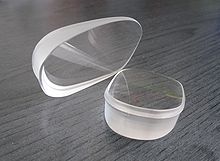Prism glasses
A prism glasses is a special glasses , the lenses of which a light-deflecting ( prismatic own) effect, and especially in the ophthalmic field of Strabology is used as a therapeutic and diagnostic tool. As a rule, every spectacle lens has different prismatic effects in every direction of view deviating from the main visual point, which, if they are not intended and serve the therapeutic benefit, can sometimes lead to considerable discomfort.
Prism glasses in ophthalmology
A prism glasses is generally in the treatment of certain strabismus used. It has at least one lens in which the optical center is not the main visual point of an eye. A ray of light emanating from a distant object is refracted towards the base as it passes through the lens. This enables simple two- eye vision despite the misalignment of one eye .
The prismatic effect can be achieved here by decentering it, or by applying a corresponding prism film to a spectacle lens, which can easily be removed again. The rule, however, are prismatically ground spectacle lenses from the outset, which are also provided with the corresponding spherical , cylindrical and, if necessary, a varifocal effect. This is advisable because decentering is only possible optically in the area of smaller angles and prism foils have a lower image quality than ground spectacle lenses due to their structural properties. They are therefore more suitable for interim solutions (diagnostic purposes, waiting time until the operation).
In the case of more pronounced misalignments of the eyes (from approx. 30 prism dioptres, which corresponds to about 15 °), prism glasses reach their limits not only in terms of manufacturing / optics, but also aesthetically. Depending on the size of the lens, they then have z. T. considerable edge thicknesses and produce color fringes ( chromatic aberration ). In addition, under certain circumstances, the wearer can become heavily weighted and cosmetically disfigured due to the optical “displacement effect” of the eyes. In addition to medical indications, these aspects should therefore also be taken into account when discussing surgical correction ( squint operation ) of the malocclusion.
Opticians manufacture corrective glasses with the lowest possible prismatic side effects. In general, the more precisely the lens centers ("optical center points") are centered in front of the pupils in the eyeglass frame, the less prismatic effects are generated, which, by the way, can all be measured with suitable means (vertex refractors, centering devices).
Some opticians and ophthalmologists also use prismatic glasses to correct so-called angular ametropia (technical term: associated heterophoria ). The associated measurement and correction methodology (MKH) is rejected by most opticians, ophthalmologists and strabologists, among other things because of the lack of scientific validation of the overall concept. However, since all glasses are "prismatic glasses" due to the underlying physics, more and more opticians are using measurements to record the prismatic side effects while determining the glasses and compensate for them in such a way that the glasses wearer is exposed to as few side effects as possible, better not at all.
See also
Special glasses with reflective prisms

Glasses with reflection prisms are used as safety glasses during sport climbing as sun glasses for relaxed reading or watching TV, or as a reversal glasses to psychological experiments.
literature
- Herbert Kaufmann (Ed.): Strabismus. With the collaboration of Wilfried de Decker u. a. Enke, Stuttgart 1986, ISBN 3-432-95391-7 .
